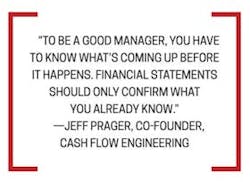Cash Isn't Just King, It's Your Lifeline
Mike Benshoof worked for his father’s custom home building business from the age of 13 to the day he left home to attend Penn State University. Mike’s father, Dan, is a second-generation builder who preferred working out in the field to being in the office and could figure roof-span calculations in his head. Yet he didn’t have a system for tracking financial metrics beyond simple bookkeeping and looking at his checking account balance.
Dan’s company regularly rode the financial roller coaster through peaks and valleys of cash flow and endured many stretches when the next bank draw was too distant to take care of bill payments due yesterday. This experience was common for many of the home builder clients Mike takes on for financial coaching at SMA Consulting, his business operation and sales management consulting company. Almost all of his clients lacked a managerial accounting system into which they could plug numbers and that could help them decide where to steer their businesses next. They also underestimated the role of cash being the lifeline of the business.
Mike worked for home building giant NVR after graduating from college, later earned an MBA, and served as an economist with the NAHB. Today he is president of Berks Homes, in Mohnton, Pa., and Red Door Homes, in New Cumberland, Pa., in addition to doing consulting work. When his dad was in his late 50s, Mike took the principles he’d learned throughout his career and taught Dan how to create a financial dashboard to keep tabs on cash and anticipate any looming red flags. Dan, now 74, still swings a hammer, but his workweek is three days long, and he actually takes vacations.
“This is what changed my dad’s life and the lives of every custom builder we’ve worked with,” Mike says. “The first step is knowing how much money you need to make each year. If you can’t tell me that, you can manage your cash flow all you want, but you’ll be chasing your tail.”
A builder can be profitable on paper yet be on the verge of shutting down if there isn’t enough cash to meet payroll, rent, and so on.
It Pays to Be Proactive
“Profit is an opinion. Cash is a fact,” says Jeff Prager, co-founder of Cash Flow Engineering, in Centennial, Colo., and co-author of Managing Your Business With 7 Key Numbers. “I’ve been lecturing CPAs for years that if you ran your business based on Generally Accepted Accounting Principles [GAAP], you’d go bankrupt because its emphasis is on reporting to third parties like banks and the SEC, as opposed to management. To be a good manager, you have to know what’s coming up before it happens. Financial statements should only confirm what you already know.”
GAAP—a common set of accounting principles companies and their accountants follow to ensure a minimum level of consistency in financial reporting across industries—will tell a builder how much income tax to send to the Internal Revenue Service each April. But it won’t indicate, throughout the course of a year, when cash balances hit a level where the builder should consider asking the homeowner for a bigger deposit or to pay for the permit, or turn up the company’s marketing activity to ensure more jobs are in the pipeline before a current project is completed.
“Too many builders aren’t proactive about cash flow management when the sun is shining,” says Noelle Tarabulski, president and founder of Builder Consulting Group, in Lakewood, Colo. “Orderly cash flow management will pay off in all phases of the business cycle, but most builders don’t focus on it until they’re in distress. It’s far better to be good at it when you don’t have to be.”
A first step toward proactive financial management is determining your breakeven—the point where you sell enough product to cover your fixed costs. Many of Tom Stephani’s clients didn’t know this number when he started working with them. Stephani, who started out building custom homes in Colorado in 1984, now runs Custom Construction Concepts, a consultancy in Crystal Lake, Ill. Builders who understand how much revenue is needed to cover overhead can better price their product, he says.
“Ask yourself: With the staff I have today and the amount of work I think we have in process or are going to have, how much more money do I need to carry my overhead and make money?” Stephani says. “In other words, what’s the key-in-the-door cost? In order to open my door each day, I have certain fixed costs I can’t escape—employees, rent, vehicle payments—that are there whether I sell one house or 10.”
For example, say a custom builder’s annual overhead is $600,000—a figure that should include the company owner’s salary. Even if the owner doesn’t take a salary, the total fixed cost calculation should include a dollar amount the owner would pay if someone else was hired to run the business, Stephani says. Divide $600,000 by the anticipated gross margin the builder wants to realize from the sale of each house; let’s use, for this example, 15 percent or 0.15. The formula would be $600,000 divided by 0.15 = $4 million in sales needed to cover overhead and the gross margin target. If the builder expects to start and complete eight houses per year, the selling price for each home must be at least $500,000 ($4 million divided by 8) just to cover overhead.
Other Tactics to Preserve Cash Flow
Stephani cautions that any amount above the $500,000 per house breakeven price shouldn’t be considered profit. The dollars realized above breakeven per unit are merely the contribution to margin. There is no profit in any single house because companies actually don’t realize profit until the end of the year. If the home builder sells just seven houses during the year instead of the eight needed to break even, there is no profit. Builders should have a contingency plan in case that scenario occurs.
Delays caused by weather can change cash flow expectations. So can a market slump. But builders also are affected by internal cycles that are independent of economic cycles, such as hiccups in their marketing plans, the loan approval process, or the local municipality’s permitting process. If builders pay attention to their financial dashboard, they can see early on how these glitches affect their cash and act accordingly.
Tarabulski is working with clients that are in various states of a tight cash flow due to an internal cycle going out of whack. One builder has dwindling funds on hand because starts were delayed. Another started projects on time but deliveries were late, and a third was so busy with production, he neglected marketing and his pipeline of new work dried up. She also comes across clients with self-inflicted wounds, such as underestimating land predevelopment and preconstruction costs or not asking for a deposit sufficient to cover those up-front expenses. So how much should a builder ask for downpayment?
“My rule of thumb is to ask clients what is their monthly overhead,” says Tarabulski. “Let’s say it’s $10,000. I then ask how many active projects they have going. Say it’s three. And how many are in predevelopment? Two. So, at minimum, five projects are going, so the overhead cost per project is $2,000 [$10,000 divided by five]. I then ask how long it takes the builder to go from design to contract. If they say six months, then it’s six multiplied by $2,000, which equals $12,000. That’s what they should get for a deposit, at minimum.”
Salary should be part of the deposit calculation, too. Here’s another quick formula using the same builder-client example.
“I ask clients: If you were busy all of the time, what would you pay yourself? They say $15,000 a month. With five projects, that’s $15,000 divided by five, which is $3,000 per month; $3,000 multiplied by six months is $18,000. That’s how you have to think. It’s a good way to make sure you can cover your overhead and your out-of-pocket expenses,” Tarabulski says.
Working in Reverse
Another road to finding breakeven is to work backward with budgeting. Prager recommends including your salary in the fixed cost total and a profit goal to compensate you for your risk. Builders tend to be too optimistic when projecting how many homes they think they can close annually and don’t include enough cushion to ensure they can stay in business. Adding a minimum profit goal to the overhead figure can help cover some of the shortfall should sales slip below expectations. Once you have a sales goal—the breakeven point with the adjustments for salary and a minimum profit—work backward to create your budget.
He also recommends taking cash flow management to the next level by making it part of the builder’s exit strategy.
“Start out with the end in mind. Know where you want to end up and reverse engineer how to run your business to get there. Make decisions based on where you want to end up. You’ll make better decisions knowing your end game, and you’ll stop making decisions based on your bank balance,” Prager says.
Even if a builder has no intention of retiring and vows to die wearing a toolbelt, every business owner should at least know how much money is needed to be financially independent. Then establish a plan—whether it’s three, five, 10 years, or more—with targets for gradually attaining that goal during each year or every couple of years.
“This is a very risky business, and it’s highly leveraged,” Prager says. “Most people in the construction business exit through bankruptcy, and that’s not the way to do it. They’re doing it on a wish and a hope, and hope is not a strategy.”
Check Your Speed
A second step toward proactively managing cash flow is to have a speedometer.
Builders with 10 closings or fewer per year would be better served by using the percentage-of-completion method for internal financial reporting. The alternative method of completed contract managerial accounting recognizes revenue and expenses when a project is completed or closed. That system is better suited for larger builders because the flow of revenue, job costs, and overhead line up more consistently on their profit and loss statements, as they have a regular stream of closings every month. If a custom home builder with three closings annually uses a completed contract and has no closings during the first quarter, that
P&L will look depressed because it shows costs and no revenue. When there is a closing in April, the business looks like it’s flush with money—that is, until bills for the delivered project are paid, in addition to overhead and expenses for prospecting and starting the next house. By May, the balance sheet will look depressed again.
A completed contract does not provide a real-time picture of the business’s cash-flow position, whereas, percentage of completion recognizes revenues and expenses as a percentage of the work completed. Actual spending can be compared with the budgeted figure and gauged with cash on hand so the builder can see, on a monthly basis, whether billings are under or over for the project. The accounting method just requires understanding basic math.
For example, you already know from your concrete subcontractor the cost of pouring a foundation. Divide that number by the total cost you figured for building the house and then multiply by 100. The result is the cost of completing the concrete work as a percentage of the total cost for the project. Convert that percentage to a decimal and multiply by the home’s sale price. The answer is the dollar figure you can use to recognize revenue for that completed portion of the project. Compare it with the cost of pouring the foundation. The difference is your gross profit or loss for that line item.
“You can set it up where you track your costs as you spend money,” Stephani says. “That expenditure goes next to your estimate for that line item, and you can do percent complete for each line item. I like to do my job costing once a month, at minimum. Some builders like to do it once per draw, and some do it at the end of a job. The end of the job is too late because you can’t recover and correct during the project if [the completed percentage revenue] line item is under cost. At each draw, or at the end of the month, if you account for each line item and estimate the percentage complete for each, you can see if you’re over or under with your billing.”
Some of Benshoof’s clients who use percentage of completion accounting are so disciplined that they connect that format to their marketing. By maintaining a steady pipeline of projects, builders can avoid being so desperate for work that they bid too low or take on a nightmare client. “It’s a dashboard where they can see in real time if they’re approaching a slow time of year and need to step on the gas and do more prospecting for clients. You can look at this every month and see what activity you need to do to keep cash flowing,” he says.
A critical cash flow management task is separating your money from your clients’ money. Commingling cash is a bad idea and even illegal in some states. Using a single account for paying overhead and a project’s direct construction costs inhibits any ability to track cash flow. Tarabulski recommends having a separate account that construction draws go into and separate accounts from which to manage the hard costs of a project and another for handling overhead. Organizing funds in that manner lets builders quickly gauge the temperature of how their cash flow management is performing just by checking balances in those accounts.
The customer’s deposit hasn’t been earned before preconstruction, so it shouldn’t be spent on payroll, rent, and car payments, Stephani says, adding, “It’s supposed to be escrowed. It should not be in the general operating account. It should be in a separate account set aside for the construction of the house, the permit, the engineering, sometimes for the plans—all the costs that have to be addressed up front before you can start construction. Once construction starts, you can get into the regular draw routine.”
If the builder needs more money to complete up-front work before draws from the construction loan can begin, rather than requesting a large deposit, Stephani would ask the owner to pay for the permit and other fees. Once construction has begun, the owner is reimbursed with funds from the construction loan. Stephani also recommends having a good relationship with a commercial lender or bank and access to a line of credit to cover reasonable gaps when cash flow is low. Access to line-of-credit cash removes the temptation of using a customer’s deposit to pay bills from another job. Just make sure you pay back the line of credit as soon as your cash stream allows.
Custom home builders typically live and breathe work in the field, interacting with their customer and the trades and solving problems on the jobsite. Learning accounting typically isn’t on the list of reasons why a person decided to be a builder. But a builder at least should understand basic accounting principles and know how their bookkeeping is done and keep that function in-house.
“The production side is the easiest side to outsource,” Stephani says. “You can find really good people to handle that for you. It’s hard to find good people to do the administration, sales, and marketing. The challenge in home building is that money is made in the back office. You have to do your accounting, and you have to do it correctly.”


